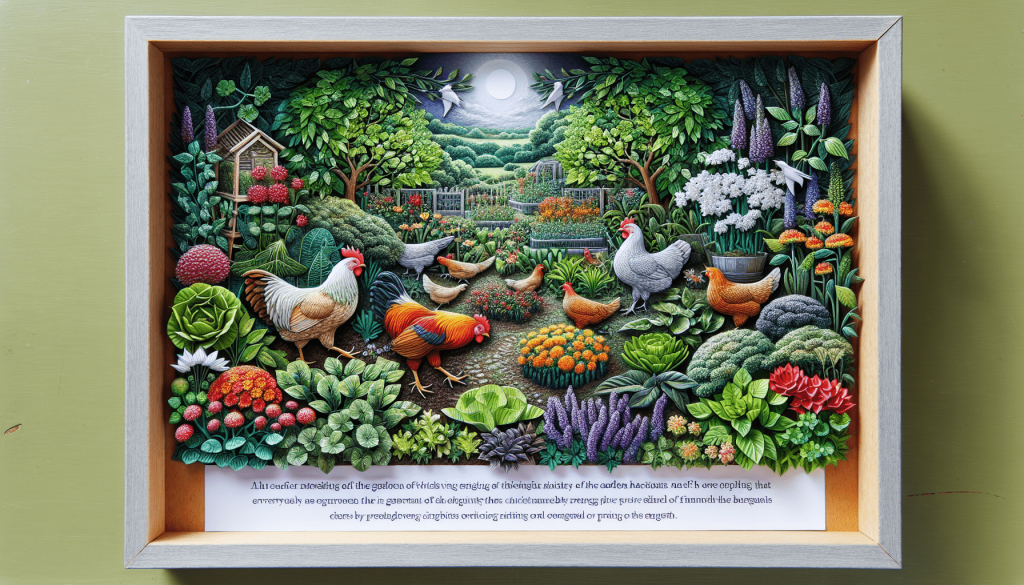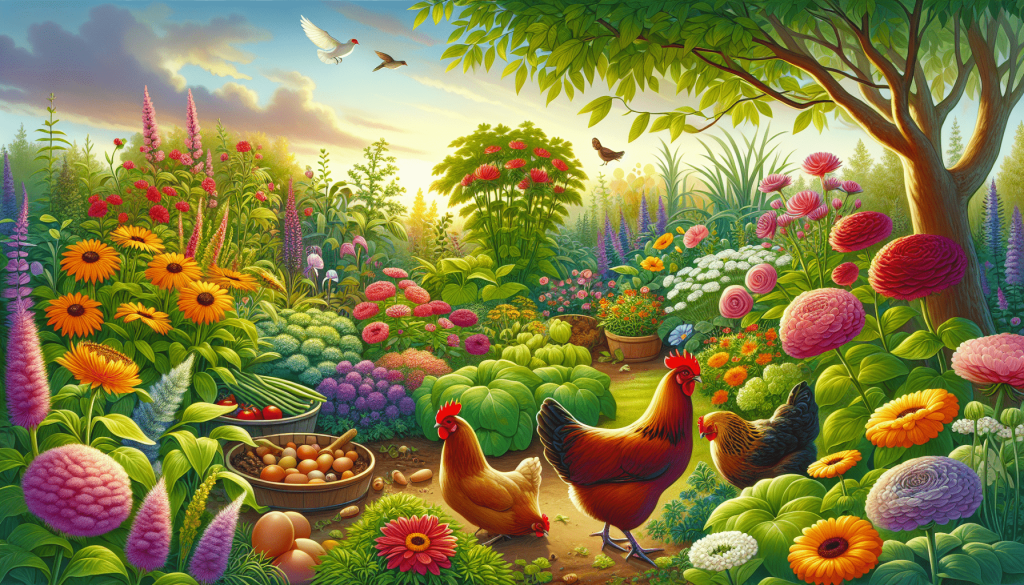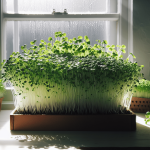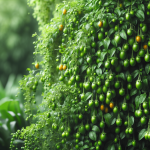This post may contain affiliate links. As an Amazon Associate, we may earn commissions from qualifying purchases.
Have you ever wondered how to integrate chickens into your garden ecosystem? The idea of chickens pecking around amongst your tomatoes and cabbages might seem chaotic, but when done correctly, it can be highly beneficial. Chickens are often dubbed the “gateway animal” for aspiring homesteaders, and for good reason. These feathered companions offer endless gifts: fresh eggs, pest control, and nutrient-rich manure, just to name a few.
In this article, we’ll unpack the best practices for combining chickens with your garden smoothly and effectively.
Understanding the Garden Ecosystem
Before you start any project, it’s vital to understand the ecosystem you’re working with. In a garden, you’re dealing with plants, soil, microorganisms, insects, and now, chickens. Each of these elements plays a crucial role, and knowing their interactions can make a big difference in your outcomes.
When integrating chickens, you’re essentially adding a new layer of complexity to this system. Chickens will forage for insects, peck at different plants, and scratch the soil—each action impacting your garden’s health.
Benefits of Integrating Chickens
Let’s get into why you’d want to do this in the first place. Here’s a rundown of the multifaceted benefits chickens bring to your garden.
Natural Pest Control
Chickens love nothing more than a juicy beetle or worm. By introducing them to your garden, you offer them a constant supply of snacks while minimizing pests that could damage your plants. This natural form of pest control can reduce your need for chemical interventions, making your garden more organic.
Fertilizer Production
Chicken manure is a powerhouse for your soil. It’s rich in nitrogen, phosphorus, and potassium—the essential nutrients for plant growth. When decomposed appropriately, it turns into a rich compost that can invigorate your plants.
Weed Management
Chickens also forage for seeds and small plants, helping to control weeds. With them poking around, you can significantly reduce the weed population, giving your desired plants the space and nutrients they need to thrive.
Soil Aeration
Your chickens’ constant scratching aerates the soil, which in turn promotes root health and water absorption. Healthy, aerated soil is the foundation of a thriving garden.

The Initial Steps
You’ve decided to combine the joys of gardening and chicken-keeping, great! But where do you start?
Pick the Right Breed
Not all chickens are created equal. Some breeds are better suited for garden integration. Here are a few options:
| Breed | Characteristics | Suitability |
|---|---|---|
| Buff Orpington | Friendly, easygoing, and excellent foragers. | Ideal for beginners. |
| Rhode Island Red | Hardy, productive, and known for their pest control prowess. | Best for larger gardens. |
| Sussex | Curious, active, and fantastic egg producers. | Versatile for any garden. |
| Wyandotte | Calm, docile, and personable. | Great for families. |
Enclosure Options
Deciding how and where to keep your chickens is crucial. You have several options for housing.
Free-Range
In a free-range system, chickens have the run of the entire garden. This allows them to eat various insects and weeds but also subjects your plants to some pecking. Ideal for larger gardens where chickens can be supervised.
Chicken Tractors
A chicken tractor is essentially a mobile coop. You can move it around the garden, allowing chickens to forage in different areas while keeping them contained. It offers the benefits of free-ranging without the risk of chickens devastating your plants.
Coop and Run
This system keeps chickens in a fixed but spacious area. You can let them out for supervised foraging and return them to their pen when needed. This is the safest option for gardens with delicate plants.
Setting Up the Perfect Integration
Now that you’ve selected your breed and enclosure, the next step is to integrate chickens into your garden’s workflow seamlessly.
Rotational Grazing
Rotational grazing is a technique that mimics natural animal movement. By dividing your garden into sections and rotating chickens through them, you prevent overgrazing and allow soil time to recover.
Creating Foraging Zones
Designate specific parts of your garden as foraging zones. This segmented approach shields your delicate plants while providing chickens with their mini-paradise.
Time-Based Integration
Timing is everything. Allow chickens into the garden during non-planting seasons or periods when certain plants are not at risk. For instance, after harvesting, chickens can clean up crop remnants and control pests residing in the soil.

Maintaining Balance
Balance is the key to ensuring chickens enrich rather than deplete your garden.
Monitoring Soil Health
Regularly test your soil to track any changes in nutrient levels. Chicken manure is rich but can be potent if not managed well. Appropriate composting will mitigate this.
Balancing Chicken Numbers
A common myth is that more chickens mean more benefits. However, too many chickens can lead to overgrazing and compacted soil. A good rule of thumb is one chicken for every 10 square meters of garden space.
Keeping Chickens Healthy
Healthy chickens are more productive. Ensure they have a balanced diet, clean water, and proper shelter. This investment in their well-being translates to more effective pest control and richer manure for your garden.
Addressing Concerns
While integrating chickens offers numerous benefits, it’s not without challenges. Addressing these can smooth your experience.
Chicken Damage
Chickens have a natural tendency to peck and scratch, which can sometimes result in garden damage. Implement physical barriers like chicken wire or low fences around delicate plants.
Predators
Chickens are vulnerable to many predators. Secure their coop and run with sturdy materials. At night, ensure chickens are safely locked up to avoid nocturnal threats.
Illness and Disease
Animal health and biosecurity are critical. Regularly check chickens for signs of illness like loss of appetite, lethargy, or abnormal droppings. Vaccinations and regular vet visits can keep your flock healthy.
Enhancing the Synergy
Creating an integrated garden isn’t just about minimizing damage but amplifying the benefits.
Companion Planting
Certain plants complement chickens well. For example, planting clover or alfalfa offers chickens a nutritious snack while fixing nitrogen in your soil.
Mulching with Chicken Litter
Turn chicken bedding into mulch. Straw and droppings from the coop can enrich garden beds after appropriate composting.
Insect Attracting Plants
Grow plants that attract insects chickens love to eat. Herbs like dill and fennel attract beneficial insects that chickens can snack on without causing plant damage.
Tools and Supplies
Implementing this system requires some specific tools and supplies. Here’s a brief list to get you started:
| Item | Purpose |
|---|---|
| Chicken Coop/Tractor | Provides shelter and protection. |
| Fencing Materials | Essential for setting boundaries and protecting plants. |
| Ground Feeder | Keeps feed off the ground, reducing waste and contamination. |
| Compost Bin | Essential for breaking down chicken manure before garden application. |
| Soil Testing Kit | Monitors soil nutrient levels and health. |
Success Stories
Sometimes, hearing about others’ experiences helps solidify your game plan. Take Farmer Jane, for instance. She integrated 10 Buff Orpingtons into her 2-acre vegetable garden. By rotating them through paddocks, she saw a 70% reduction in pest damage and her plants thrived on chicken-produced compost.
Or consider Bob and Sue’s backyard garden in suburbia. They manage with just three Rhode Island Reds and a well-built chicken tractor. Their raised beds have never looked better, thanks to the periodic chicken “tilling.”
Conclusion
By blending chickens into your garden ecosystem, you’re creating a richer, more sustainable environment. The benefits are numerous: fewer pests, healthier soil, and happier, more productive plants. Start with careful planning, choose the right breeds, and balance their presence for optimal results. Remember, the goal is synergy—a harmonized environment where every component contributes to the health and productivity of the whole system.
You, too, can have a thriving, harmonious garden-chicken integration with just a bit of effort and attention to detail. The results will be not only sustainable but incredibly rewarding as well. Happy gardening!








